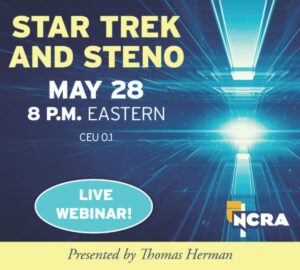By Jen Schuck
CART captioning has come a long way in the past 10 years. Gone are the days of sitting next to the client with cables strewn all over the place, and it does not take ong to figure out that fewer cords are better when providing any kind of captioning services. Still, power outlets seem to be a commodity today as everyone has an electronic device of some sort. Ever try to charge a device at an airport? Below are just a few of the many areas in which CART captioning has changed over the past decade.
THE STENO MACHINE
Every CART captioner has a steno machine and these machines have gotten significantly smaller over the years. The most lightweight machine on the market today is the LightSpeed, weighing in at only 2.6 pounds, but there are many options on the market weighing less than five pounds. This is a welcome change, as weight and size are a big consideration when providing CART captioning on a campus or in any setting where being mobile is imperative. Today’s most up-to-date machines also offer wireless connectivity to CAT software, which eliminates tethering CART captioners to their laptops. In addition, the battery life on today’s machines has also greatly improved.
THE LAPTOP
There is an array of laptops to choose from these days. While everyone has a brand preference, the number of USB hubs on a machine is still one of the major factors to consider, followed by size and weight. Manufacturers now offer immense power in a thin, lightweight machine. If the consumer is going to be using the CART captioner’s laptop to view the text, a larger screen may be preferable. Luckily, this does not mean that the laptop has to weigh you down. There are nice thin laptops with large screens on the market with some brands even offering up to seven hours of battery life – again, one less cord and no need for that elusive power outlet.
DELIVERING CART CAPTIONING
Once you have the basic needs covered, next comes the question of how your consumer is going to receive his or her CART captions. There are so many more options in 2014 than there were in 2004. For example, personal devices are the smallest and lightest way to go, but there’s also the option of outputting to a tablet, which will require Internet access or a LAN connection. Advantage Software offers BridgeMobile as a platform to view text on any computer with Internet access, and Stenograph offers CaseViewNet. These are great options to transmit text to a consumer, either on-site or remotely. Contact the vendors for more information.
If Internet access is not available at the location of the job, access can be supplied by a hotspot, something a lot of cell phones have the ability to do now. Contact your cell service provider for further details. If you have to connect to the Internet via a LAN, today’s routers are even smaller and more convenient to carry than they have been in the past. Check with your CAT software vendor to see if a specific brand is recommended.
If Internet access is not going to be available in any form, Stenocast offers products to output to netbooks or other computers via Bluetooth technology. They offer products to connect steno machines to laptops as well as to connect the CART captioner’s laptop to the consumer’s laptop. Check out stenocast.com for more information.
For those CART captioners who caption large conferences, Text on Top is a great choice to eliminate the need for projectors and extra screens. This is a wireless device that allows a CART captioner to place captions onto a screen that is also displaying a PowerPoint or other type of presentation. The output of the CART captions look like closed captioning through an encoder, but it only uses two USB devices: one on the CART captioner’s computer and one on the computer displaying the PowerPoint. For more information, check out text-on-top.com.
With technology moving so fast, I can only imagine what the next decade will bring. Making CART captioning more mobile may possibly be the next frontier. It’s been done, but requests to make it more readily available are occurring more often. Devices like Google Glass may allow walking CART captioning (see “A Glimpse of the Future“) to be more commonplace in the future.
CART captioning is definitely a growing field. With all of this emerging technology and equipment becoming lighter and smaller, the possibilities to positively change our consumers’ lives are endless.
Jen Schuck, RDR, CRR, CBC, CCP, is a CART provider in Scottsdale, Ariz., and the chair of NCRA’s CART Community of Interest. She can be reached at jen@jsreporting.com.












